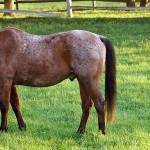Shedding Light on Hair Growth and PPID in Horses

When you see an old horse with a long, thick coat, do you think he has an overdue date with a shedding blade or do you instantly contemplate pituitary pars intermedia dysfunction (PPID, Cushing’s disease)?
PPID occurs in about 20% of horses and ponies aged 15 years of age or older. The most common physical indicators of disease include hair overgrowth, known as hypertrichosis, and delayed shedding of the winter coat.* A little extra hair may seem innocuous, but owners of affected horses and their veterinarians can attest this isn’t always the case.
“Hypertrichosis and delayed shedding are aesthetically unattractive to many owners. More importantly, though, excess hair can contribute to skin infections, particularly as temperature and humidity rise during spring and summer,” explained Kathleen Crandell, Ph.D., a nutritionist for Kentucky Equine Research.” Because horses and ponies with PPID are often immunosuppressed, infections may take hold quickly and be difficult to resolve.
Abnormal temperature regulation due to altered sweating patterns can also be observed in horses with PPID. While body clipping is widely adopted, clipping doesn’t fully ease the problem because the coat remains thick.
Prolactin, melatonin, and daylength all play important roles in controlling the hair follicle cycle. Specifically, melatonin suppresses prolactin and, in turn, daylight suppresses melatonin. Using this logic, a team of veterinary researchers recently attempted to extend a horse’s day length to minimize hypertrichosis by suppressing melatonin and prolactin.**
Ten horses diagnosed with PPID were fitted with wearable blue light masks, like those used in broodmares to extend photoperiod, to achieve a consistent 14.5-hour daylength from July through October. An additional eight PPID horses served as a control group, exposed only to natural light.
At the end of October, horses that wore the blue lights had lighter hair weights compared to control horses.
“Extending photoperiod may be used as an alternate strategy for managing hypertrichosis. At present, pergolide is the only recommended option for improving hypertrichosis and increasing shedding in PPID horses,” explained Crandell.
Maintaining a healthy coat in the face of PPID can be supported by using a high-quality supplement designed specifically for hair and hoof health.
*Ireland, J.L., and C.M. McGowan. 2018. Epidemiology of pituitary pars intermedia dysfunction: A systematic literature review of clinical presentation, disease prevalence and risk factors. Veterinary Journal 235:22-33.
**Miller, A.B., B.A. Murphy, and A.A. Adams. 2022. Impact of blue light therapy on plasma adrenocorticotropic hormone (ACTH) and hypertrichosis in horses with pituitary pars intermedia dysfunction. Domestic Animal Endocrinology 78:106651.








